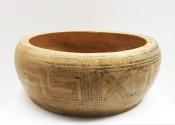
Container (Pyxis) with Two Horses
This vessel belongs to a class of objects produced throughout the Geometric period (900-700 BCE) known as a pyxis (plural pyxides). This example was produced in the Late Geometric Ia period (ca. 760-750 BCE) in Attica, the region including Athens and its surrounding area. It has horse figurines in the place of a traditional knob or handle, giving this variety the moniker “Horse Pyxis.” Typically, most examples have pairs of corresponding holes piercing the lid and the rim on opposite sides in order to attach the lid and bowl. On this example, only one pair of holes survives.
Barbara Bohen, a professor and specialist in Athenian pyxides, attributed this pyxis to the Fisch-Werkstatt, or “Fish Workshop,” and it was probably made in the same Athenian workshop as other flat-topped containers with horse attachments. Many pyxides produced by this workshop are identifiable by painted “fish” that appear on the disc with the horses. On this example and others from the workshop, the “fish” are created by two overlapping semi-circular lines with a horizontal line in the middle, acting almost like a brand. The design is badly faded on this lid but still visible if you look closely underneath the horses. The horses had additional decoration (banding that may indicate harnesses), which is also fading. Like other pyxides, the body is decorated with a hatched meander, a Greek pattern with a continuous interlocking series of bends, here filled with hatched lines. The vessel is also decorated by four-leaf flowers with dotted rosettes between the petals within “metopes” or windows in the decoration, which are another hallmark of the workshop.



